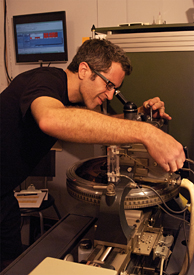
Jason Ward works on the Neumann VMS-70 vinyl-cutting lathe.
The Midwest now has its own top-flight, multiformat mastering studio. Chicago Mastering Service, co-owned by Bob Weston (also of the independent band Shellac) and Jason Ward, opened in 2007 to provide analog and digital mastering for CD, as well as lacquer cutting for vinyl.
The control room was designed by Bob Alach’s Alactronics firm. According to Weston, “The most important things to us in the design of the studio were the room acoustics and monitoring. We can always buy new gear and software, but the listening environment needs to be extremely detailed and accurate from the start.”
The monitoring setup situates the speakers behind a sheer fabric wall in the front of the room. The computer’s display is projected onto an acoustically transparent textile screen from Screen Research. This setup circumvents acoustical reflection problems that would arise from physical units on the console itself, near each other and the listening position.
The analog mastering transfer console was custom-built by Shea Ako. “One of the elements we requested is a button that flips the source between either the ATR-102 tape recorder or the computer. When the computer is the selected source, the tape machine is routed to the inserts [to be used as an effect] without repatching anything,” he says. “The console also has a built-in M/S encoder and decoder with a width control that we can patch into any two inserts for M/S processing.”
All projects are mastered primarily in the analog realm. “Even when the source material is digital, we send the audio out from the workstation through our transfer console, inserting analog EQ and compression/limiting, and then maybe have a couple plug-ins on the way out from or on the way back into the workstation.”
Rega and Technics turntables are available for checking lacquers. According to Weston, “We’ll look for sections in the music that will pose the greatest difficulties during cutting or playback, like sibilance or loud, exposed vocals. Then we’ll cut those bits onto a lacquer, bring it to the turntable and play it back next to the source audio while A/B’ing to see if it we need to make adjustments. We first master and assemble any project in our mastering software. Then we either generate the 16-bit CD master or play back through the D/A converters at 24-bit to feed the lathe.”
The studio has two complete mastering workstations: Ward’s PC-based Sequoia system and Weston’s Mac running soundBlade. “We direct the audio using a digital router, and the keyboards and monitors in both the control room and machine room can be assigned to either or both computers,” Weston says.
Chicago Mastering boasts the only Neumann VMS-70 cutting lathe in the region, along with a Zuma variable pitch and depth computer. “Right away, when we were first talking about the studio, we both really wanted to have a lathe. We thought it would be a cool thing to learn,” and of course, there is still a healthy market for vinyl. Jokes Weston, “We also thought it would lend us a sense of legitimacy.”

